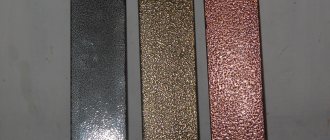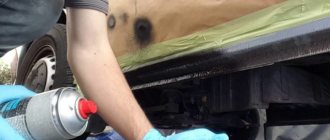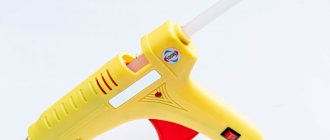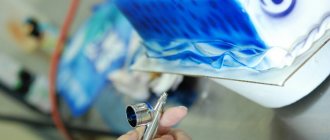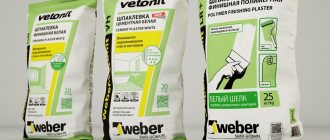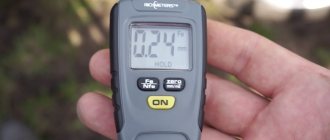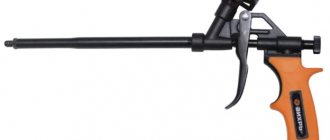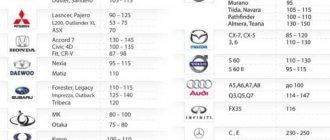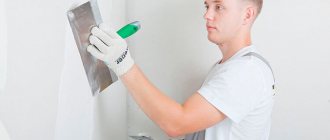Corrosion also causes many problems in construction. Metal buildings, garages, hangars, etc., fences, load-bearing parts of frame structures, and roofing suffer. This “ruthless enemy” does not spare plumbing and household appliances, especially those in contact with water.
Corrosion processes are not easy to deal with, but it is still possible and definitely necessary to fight. And it is very good that man has created special “weapons” for these purposes - I mean a fairly wide range of different means. These are what we will talk about: means of protecting metals from corrosion - types, methods of application, rating of the most effective compositions.
Ways to combat corrosion
Metal corrosion is a destructive, lattice-destroying, redox chemical process. It is most often caused by the high chemical activity of the metals themselves - many remember from the school chemistry course the “line” of the activity of elements. It can be activated when unfavorable conditions are created, for example, high humidity and low temperatures, in an aggressive salt, acidic or alkaline environment.
Most often we have to deal with corrosion of ferrous metals, that is, various types of steel and cast iron, used literally everywhere, in all spheres of human activity. The process begins to reveal itself by the appearance of red stains or stains on the metal surface.
If corrosion is not dealt with, it can show its extremely destructive power - metal products quickly become unusable.
If no steps are taken, the outbreak begins to grow, capturing more and more areas. And sometimes this happens unnoticed. Thus, many areas of mechanisms, instruments, etc. - are simply hidden from view, and can only be seen when the unit or entire device is completely disassembled. And other pockets of corrosion may be hidden under a layer of paint for the time being, and only when the process has gone very far - first appear in the form of swellings, and then as rust breaks out.
Some owners try to deal with identified pockets of corrosion mechanically. That is, by grinding the damaged area with sandpaper or special discs, reaching the “healthy” metal.
However, such a technique, if it can be applied, should be done with extreme caution, and only as a preliminary step, before applying special compounds. Only mechanical cleaning is a very ineffective means.
Spot corrosion showing through the paint layer
It is especially difficult to remove small pinpoint rust using this method, since during the cleaning process they become clogged with finely dispersed corrosive dust, and they become practically invisible. But the trouble is that they don’t go away, and will definitely show themselves in the future, even after coloring. Therefore, chemical treatment is more reliable.
In addition, if thin metal is affected by rust, then during cleaning, under the pressure of brushes or abrasive material, it can be damaged down to a through hole.
In this regard, it is recommended to use chemical compounds that clean the metal and prevent the occurrence of corrosion in the future. Moreover, with their help, you can even successfully deal with outbreaks in hard-to-reach areas, where you cannot reach the affected area by any other means without disassembling the mechanism.
Why does rust form?
Any environment is considered aggressive for unprotected metal. For this reason, its surface layer is constantly exposed to all sorts of chemical reactions. Subsequently, rust stains appear, the appearance of the product is lost, and its strength characteristics deteriorate.
In addition, iron devices that are constantly exposed to excessive temperatures suffer from corrosion: engine components, furnace fittings, turbine blades. Metal bases that are in prolonged contact with various liquids (water, alcohol) are also susceptible to corrosion.
Objects that remain in water for a long time are most susceptible to corrosion. Source jaspowdercoating.com
Types of corrosion protection products
There are several types of compounds designed to combat corrosion. These are rust converters, special primers and anti-corrosion coatings:
- One of the most commonly used and effective products are the so-called rust converters. These compositions are capable of not only removing at the chemical level, but transforming the resulting corrosion products into a protective, fairly strong film, a kind of surface primer. Such compositions are economical in consumption and perfectly perform the functions assigned to them.
An example of a high-quality rust converter
Converters are sold in liquid form (solutions or suspensions), and you can choose the optimal form of application, depending on the location of the damaged area - whether it will be applied with a brush, or whether using a sprayer seems more convenient.
The converters are suitable for processing any metal parts, but provided that the thickness of the affected layer does not exceed 15÷20 microns. The composition will not penetrate deeper - it will simply cover the damaged area with a phosphate film, and the corrosion center remaining underneath will continue to corrode the metal.
- Metal primers are no less popular than rust converters. You can find different versions of these chemicals on sale - these are passivating, phosphating, protective, insulating, as well as transforming (that is, in many ways similar to the converters mentioned above) and others.
- Another group of materials for protecting metal from rust are special anti-corrosion coatings used in combination with the other materials mentioned above.
Types of corrosion
Corrosion has a wide distribution and a variety of conditions and environments in which it can begin. Therefore, there is no specific classification of different cases of corrosion yet.
The table shows the extensive classification of corrosion that exists today.
| Condition/environment conducive to the corrosion process | Types of corrosion | |
| By type of aggressive environment | gas corrosion | |
| corrosion in non-electrolytes | ||
| corrosion in electrolytes | ||
| atmospheric corrosion | ||
| underground corrosion | ||
| corrosion due to stray currents | ||
| biocorrosion | ||
| According to the conditions of the corrosion process | contact corrosion | |
| crevice corrosion | ||
| Full immersion corrosion | ||
| partial immersion corrosion | ||
| corrosion during alternating immersion | ||
| intercrystalline corrosion | ||
| friction corrosion | ||
| stress corrosion | ||
| By nature of destruction | complete corrosion | uniform corrosion |
| uneven corrosion | ||
| selective corrosion | ||
| local corrosion | pitting corrosion | |
| pitting corrosion | ||
| corrosion spots | ||
| through corrosion | ||
| intergranular corrosion | ||
| According to the mechanism of the corrosion process | chemical | |
| electrochemical | ||
The huge number of types of corrosion has led to the emergence of an equally large number of methods and techniques to combat each of them. But this issue is not closed and work continues to create new methods that will be more effective.
Removing rust from metal surfaces
If we are talking about cars, then corrosion most often appears on the car body. It is clear that any car owner is interested in the “health” of his “pet”, and regular updates of anti-corrosion protection are entirely on the owner’s conscience. But it also happens that corrosion finds loopholes, or due to some circumstances, vulnerable areas appear on the protective layer.
If the slightest signs of damage are detected, it is necessary to take immediate action, otherwise the focus of active oxidation will not only expand, but also go deeper into the metal. If the metal sheet is eaten through by rust, then other, more expensive repair methods will have to be used.
Here you need to act quickly: if you come to your senses in time, you can still return the damaged area to its original appearance (provided you choose the right shade of paint).
Removing rust from a car body - applying converter with a brush
Any of the selected rust removers must be used in the prescribed sequence. Only in this case can you achieve the desired effect:
- The first step is to carefully clean the damaged area from loose rust using a wire brush and then sandpaper of the desired grain size.
- Next, the surface is treated with a rust converter;
- The next step is to wash the treated area several times (if specified in the instructions for the rust converter, since sometimes this is not required.)
- After this, the metal surface is dried with a rag or using a hair dryer;
- Once the surface is ready, they move on to painting work.
When cleaning, you may find that rust has already made a through hole in the metal. If it is very small, then you can try to seal it with putty using fiberglass. If the hole has reached a significant size, it is impossible to do without welding a patch, and this will require special equipment and, naturally, stable skills in carrying out such repair and restoration work. In order not to let things get to this point, you should carefully monitor the state of the car’s anti-corrosion protection in order to stop the onset of metal corrosion at an early stage.
Cleaning the area damaged by corrosion
Restoration of an area damaged by corrosion using a converter and soil is carried out in approximately the following sequence:
- Cleaning metal from loose layers of rust.
- Degreasing the cleaned area.
- Rust converter treatment.
- If necessary, the next step is puttying, and after it dries, sanding.
- Then the surface is degreased again.
- The next stage is the application of protective primer in one or two layers.
- Next comes two or three layers of adhesive primer;
- After this, the repaired area is painted in several layers.
- A special varnish is applied on top of the paint.
When performing all work using anti-corrosion chemicals, it is necessary to comply with safety regulations. A prerequisite is the use of protective equipment - rubber gloves, goggles and a respirator. If necessary, the metal surface surrounding the damaged area should be covered to eliminate the possibility of contact with the converter, primer, and finishing paints and varnishes.
* * * * * * *
It must be said right away that the complete restoration of a heavily damaged area with its subsequent finishing painting is a rather difficult task, and not everyone can do it. That is, if you have doubts about obtaining an acceptable result, it is better to turn to specialists. This is not cheap, and therefore the best solution is to try not to bring your equipment to a state that requires such intervention. That is, to nip the appearance and development of areas affected by corrosion, as they say, “in the bud.” There are a lot of resources for this.
Next, we will present a rating of the best compounds that can effectively combat the corrosion process that has arisen on the surface and in the hidden cavities of the car.
Quality control of work performed
The methods used to protect against metal corrosion are subject to quality control. Performed to verify previously performed production controls. Defect prevention. Development of measures to eliminate detected defects. Quality control of anti-corrosion work begins with checking the documentation. Documentation on the anti-corrosion protection facility, the materials used, and product quality certificates must be provided. Upon completion of the quality control of the work, a report is drawn up containing information about the location of the work, the state of the work performed, the materials of their grade and consumption used. Information about the organization that performed the work, and the signatures of the persons who carried out the work. The commission conducting quality control checks the following parameters:
— type of anti-corrosion coating, there should be no areas that have not been treated.
— the thickness of the coating layer is checked by measuring in various places where poor quality processing is presumably possible.
— the adhesion of the paint and varnish material to the metal surface is controlled.
Which composition is better to choose?
A large number of products from domestic and foreign manufacturers are on sale (both in hardware stores and in auto parts, auto chemicals and cosmetics stores, and in hardware stores). An interesting fact is that users especially highlight formulations made by companies in Russia and the USA. Products from many European brands also perform well.
Rust converters of various types
The quality and efficiency of the presented products have been tested by practical application - all of them, if the technology of use is followed, give the expected result. Therefore, they are readily used by both repair service workers and home craftsmen.
It is also pleasantly surprising that consumers put domestic formulations in first place. Most likely, because they were developed taking into account Russian climatic and road conditions.
How to fight rust
In practice, many proven methods are used to extend the service life of iron products. But the most effective of them is treatment with chemicals (for example, inhibitor compounds). After applying them in a thin layer, the metal surface acquires reliable protection from destruction. Such compositions are often used for prophylactic purposes. Among other highly effective methods, it is worth noting the removal of rust manually or with power tools, folk remedies, and the application of anti-corrosion substances.
Mechanical cleaning
Manual treatment of iron against corrosion involves the use of a stiff brush or coarse sandpaper. Parts can be processed wet or dry. In the first case, the sandpaper is wetted in kerosene, in the second, the rust is simply scraped off.
In addition, mechanical cleaning of rusting materials is possible using the following tools:
- Bulgarian;
- electric drill (metal brush as an attachment);
- Sander;
- sandblasting machine.
The manual method is used in small areas and allows you to clean surfaces thoroughly. Power tools significantly speed up the process, but at the same time they can damage parts. When processing them, a relatively large layer of metal is removed. A sandblasting device will help to carefully remove corrosion. It is not available to everyone due to its high cost.
When processing products with sandblasting equipment, the metal surface is not ground down; a powerful jet of sand carefully removes rust Source uis-m.ru
TOP 8 means of combating metal corrosion
| Photo | Name | Rating | Price | |
| #1 | Rust converter "ASTROhim Antiruster" | ⭐ 4.9 / 5 14 — votes | Find out the price | |
| #2 | Anticorrosive "DINITROL 479" | ⭐ 4.8 / 5 8 — votes | Find out the price | |
| #3 | Rust converter "Fenom" | ⭐ 4.8 / 5 15 — votes | Find out the price | |
| #4 | Anti-corrosion agent “Hi-Gear Black beauty” (HG5754) | ⭐ 4.7 / 5 8 — votes | Find out the price | |
| #5 | Permatex Rust Treatment Converter | ⭐ 4.65 / 5 6 — votes | Find out the price | |
| #6 | Rust converter “Hi-Gear No-Rust” (HG5718) | ⭐ 4.6 / 5 3 - votes | Find out the price | |
| #7 | Rust converter "Autoprofi Galvanization" | ⭐ 4.55 / 5 10 — votes | Find out the price | |
| #8 | Anti-corrosion soundproofing agent “Noxudol 3100” | ⭐ 4.5 / 5 5 — votes | Find out the price |
Which anti-corrosion compound would you choose or recommend?
Take the survey
If we analyze the reviews of Russian users, the leaders in the domestic market of anti-corrosion products were named such brands as ASTROhim, Fenom, Permatex, Hi-Gear, Autoprofi, ABRO and some others . The products of these companies have passed all the necessary levels of licensing and safety and quality certification. To avoid purchasing counterfeits, it is recommended to safely ask the seller for copies of documents confirming the originality of the products.
#8. Anti-corrosion soundproofing agent “Noxudol 3100”
"Noxudol 3100" is a Swedish product. The composition is designed to protect the car not only from corrosion, but also from the penetration of external noise into the interior, since its viscous structure has good noise and vibration absorption properties.
Anti-corrosion and anti-noise agent “Noxudol 3100”
Noxudol 3100 goes on sale in 1 liter cylinders. The material is suitable for processing both external and internal surfaces of different parts of the car. The composition has a fairly thick consistency, which is why it takes a long time to dry, which will have to be taken into account when choosing this particular anticorrosive agent.
The method of applying Noxudol 3100 is indicated by the manufacturer on the packaging - both spraying and application with a painting tool are acceptable.
Composition characteristics:
| Characteristic name | Indicators |
| Manufacturer country | Sweden |
| Product type | Insulating anti-corrosion coating |
| The basis | Water |
| Application method | Spray or brush |
| Compound | Not disclosed |
| Peculiarities | Forms a protective layer that protects against corrosion and reduces the spread of noise. |
| Minimum metal surface temperature during application, ˚С | not lower than +10 |
| Application area | Anti-corrosion treatment of cars |
pros
- Pronounced elasticity of the composition, immunity to abrasive load.
- Excellent moisture-proofing abilities.
- The composition is very easy and even to apply.
- The composition is immediately positioned both as an anti-corrosion agent and as an “anti-noise” - it fully meets the requirements for high-quality sound insulation of the cabin.
- Excellent resistance to any theoretically possible temperature changes during operation;
- Versatility - suitable for all surfaces of the car.
Minuses
- Duration of drying of the first layer;
- The cost is too high for the average Russian consumer.
Noxudol 3100
#7. Rust converter "Autoprofi Galvanization"
Autoprofi is another Russian brand popular among car owners. Our rating includes the “Galvanization” rust converter, which goes on sale in 500 ml bottles equipped with an adjustable spray bottle. By setting the desired jet length or torch width, the product can be sprayed even on hard-to-reach car surfaces.
A very worthy domestic product – rust converter “Autoprofi Galvanization”
The solution is made on the basis of orthophosphoric acid, which is modified by a number of different additives. After the reaction, the resulting coating is enriched with zinc molecules, known for its high anti-corrosion qualities.
After each applied layer has dried, as the manufacturer suggests, the converter does not require rinsing - just wipe the treated surface. However, experts who have worked with this solution still recommend washing it by adding a little soda to the water for this purpose.
Composition characteristics:
| Characteristic name | Indicators |
| Manufacturer country | Russia |
| Product type | Rust converter solution |
| The basis | Acid with zinc enrichment |
| Application method | Spraying with a spray bottle, application with a brush is possible. |
| Compound | Orthophosphoric acid - 30%; nsurfactants, butanol - 5%; deionized water - 30%; active additives - 5÷15%; dye - 5%, corrosion inhibitor |
| Peculiarities | Forms a protective film, increases the adhesive ability of materials |
| Application area | Anti-corrosion treatment of car parts and widespread use in everyday life |
Mode of application:
- After cleaning the surface, shake the can and apply the product to the corroded dry area.
- When the layer dries, the remaining product and rust residues should be removed with a coarse, but not metal brush.
- Then repeat the application once or twice, after which the remaining product should be cleaned with a dry cloth or brush.
pros
- Quickly removes corrosion from the surface.
- Provides long-term and reliable protection against the appearance of new rust spots.
- Due to the clever design of the sprayer, it is convenient to treat any surface, including hard-to-reach places.
- Quite affordable price.
Minuses
- If you ignore the washing step, the paint composition may adhere very unevenly to the surface.
- Smudges may appear during application.
Autoprofi Galvanized
#6. Rust converter “Hi-Gear No-Rust” (HG5718)
Hi-Gear is an American brand whose products are very popular in car service centers in many countries around the world. Over the period of its use, the auto chemical products of this manufacturer have gained complete trust among both professional and home craftsmen.
The HG5718 converter goes on sale in the form of an aerosol, in cylinders with a net mass of 370 g.
Rust converter with protective effect “Hi-Gear No-Rust”
Thanks to the aerosol version, application of the composition is significantly simplified, even in hard-to-reach places.
Converter characteristics:
| Characteristic name | Indicators |
| Manufacturer country | Licensed in the USA, produced more often in Russia |
| Product type | Chemical rust converter |
| The basis | Alcohol |
| Application method | Aerosol spray |
| Peculiarities | Forms a protective film, increases the adhesive ability of materials |
| Temperature of the metal surface during application, ˚С | +10 to +30 |
| Application area | Anti-corrosion treatment of automobile bodies and other steel parts of machines and building structures. |
Mode of application:
- Surface preparation is carried out in the same way as when using other products. That is, cleaning with a wire brush and sandpaper, rinsing and drying.
- Before applying the composition, the bottle should be shaken well.
- Spraying should be done until the surface is evenly covered with the converter. When applying, the cylinder should be at a distance of 150÷300 mm from the surface to be treated.
- The composition is applied in two or three layers, each of them must dry for at least three to five minutes.
- Rust converter that gets onto adjacent areas of the surface is removed with alcohol.
- Before you start using or painting the treated part, the last applied layer of converter must be left for at least 2–3 hours.
When working with aerosol, it is necessary to protect the respiratory tract and mucous membranes of the eyes well to avoid chemical burns.
pros
- Convenient and quick application of the composition even in hard-to-reach areas of the structure.
- Long-lasting and reliable corrosion protection;
- Fast setting of each layer;
- The material performs two functions at once - it removes rust and primes the surface.
Minuses
- The material is very aggressive and requires the use of protective equipment for the respiratory system, mucous membranes, and eyes.
- High cost of the cylinder.
HG5718
#5. Permatex Rust Treatment Converter
“Permatex Rust Treatment” is an American product that produces several types of similar formulations.
Rust converter “Permatex Rust Treatment”
Permatex Rust Treatment is packaged in a 236 ml plastic jar. This solution is a quick-drying, latex-based solution that is milky white in color. A solution is applied to the damaged area of the metal - it will stop the development of corrosion by forming a protective layer of soil on the surface. "Permatex Rust Treatment" transforms old rust and prevents the formation of new lesions.
This compound can even be applied directly to rusted, wet metal. It performs several functions at once - it dries, drawing out moisture, transforms rust and primes the area damaged by it.
Composition characteristics:
| Characteristic name | Indicators |
| Manufacturer country | USA |
| Product type | The solution is a rust converter with priming ability. |
| Solution base | Latex |
| Application method | Using a brush |
| Peculiarities | Forms a durable, moisture-proof protective film |
| Temperature of the metal surface during application, ˚С | From +10 to +32 |
| Application area | Anti-corrosion treatment of steel parts |
Mode of application:
- The surface is cleaned of dirt and lubricants. The loose layer of oxides and old paint are removed.
- Then you should thoroughly wash off the rust particles.
- The solution must be mixed well before use.
- Apply the composition to the surface generously, with a sponge or brush.
- Within 20 minutes, the color changes from purple to black, regardless of humidity and air temperature. If the color changes unevenly, this indicates that another layer of material should be applied.
- The second layer is applied 15÷30 minutes after applying the first.
- Before applying primer or paint, the treated surface should be left for at least 24 hours.
pros
- The applied composition is converted into a black protective coating under the influence of iron oxide.
- The solution is non-toxic, non-flammable and completely safe.
- Rapid action is noted.
- The composition can be applied to a damp surface.
- The material performs two functions at once - it removes rust and primes the surface.
Minuses
- You have to leave the treated area for too long before painting.
- High price.
Permatex Rust Treatment
#4. Anti-corrosion agent “Hi-Gear Black beauty” (HG5754)
"Hi-Gear Black beauty" is an anti-corrosion product from a famous American brand. Supplied on counters in aerosol cans. The layer applied to the surface is an elastic coating - the material acquires this quality due to the rubber filler contained in it.
Anti-corrosion agent – bitumen-based coating “Hi-Gear Black beauty”
“Hi Gear Black beauty” has excellent coverage and excellent adhesive properties. The product is suitable for treating the underbody, fenders, sills and other lower and upper surfaces of the car. In service conditions, craftsmen use the composition to treat welds, surfaces covered by panels, trunk, etc.
An anti-corrosion agent can protect metal from reagents applied to the road surface in winter, salt, and atmospheric influences.
Surely there will be a use for this composition in private households - the site is full of steel structures that require reliable protection against corrosion.
“Hi Gear Black beauty” is able to displace moisture from joints and crevices, forming a waterproof layer. In addition, due to the rubber filling, unlike conventional bitumen, the material is resistant to low temperatures. It does not wear out during use and dries quickly after application. A layer of material applied to the bottom reduces road noise and vibrations of the body structure, which significantly increases the operating comfort of the vehicle. If necessary, the protective coating can be covered with primer and paint compositions.
Composition characteristics:
| Characteristic name | Indicators |
| Manufacturer country | Licensed in the USA, produced more often in Russia |
| Product type | Aerosol coating |
| The basis | Bituminous |
| Application method | Spray |
| Compound | Oxidized bitumen, petroleum distillers, butane, propane, rubber, functional additives |
| Peculiarities | Forms a protective film, increases the adhesive ability of materials |
| Minimum metal surface temperature during application, ˚С | not lower than +10 |
| Application area | Anti-corrosion treatment of metal, in particular the underbody and wheel arches of cars. Resistance to abrasive loads and the possibility of painting allow the material to be used as an anti-corrosion primer when processing steel building structures. |
Mode of application:
- The surface to be treated is cleaned of the remnants of the previously applied anti-corrosion coating, dirt and dust;
- The metal is cleaned of rust using abrasive methods, then treated with a rust converter, after which the area must be degreased with white spirit or gasoline.
- Next, the surface should be thoroughly dried.
- The container of anti-corrosion agent is shaken vigorously for about a minute.
- The composition is applied in parallel strips, each of which will overlap the previous one by 20÷30 mm;
- During the first application, 2÷3 layers are applied; during subsequent repairs, another 1÷2 layers can be added;
- Drying of the coating is carried out for at least 24 hours.
- After drying, remove any product that gets on the surface near the area to be repaired. This can be done using HG5625 or HG5628, which are specifically designed for removing bitumen stains.
It is not allowed to spray the composition near an open fire, or to carry out work at temperatures above +40 degrees.
Let's take a look at the advantages and disadvantages, according to user reviews:
pros
- Very high degree of protection of the metal surface.
- Convenient application of the composition.
- High-strength adhesion to the surface.
- Abrasion resistance.
Minuses
- High price.
HG5754
#3. Rust converter "Fenom"
“Fenom” is another Russian-made product, available for sale in 0.11 liter plastic bottles. It would seem that the product has a low price, but given the small volume of packaging, we can immediately conclude that you will obviously have to buy more than one bottle. Therefore, the factor of affordable cost turns out to be quite “vague”.
"Fenom" - rust converter into soil
“Fenom” is suitable for removing rust that has already appeared, and for semi-preparatory processing of metal before painting. The composition creates excellent adhesion between the primer and paint layer, protecting the metal from corrosion damage for at least 5–7 years.
"Fenom" very quickly removes rust from metal, transforming it into a hard layer of soil. This is its main advantage over other similar materials.
Composition characteristics:
| Characteristic name | Indicators |
| Manufacturer country | Russia |
| Product type | solution |
| Solution base | acidic |
| Composition of the solution | Orthophosphoric acid; corrosion inhibitors; antioxidants; water-soluble phosphates |
| Application method | Recommended – with a brush |
| Peculiarities | Forms a protective film over which painting can be carried out. |
| Minimum surface temperature during application, ˚С | 10 |
| Application area | Anti-corrosion treatment and repair of car bodies. Can be widely used for household purposes |
pros
- There is no need to rinse off the solution before applying paint.
- The resulting film provides long-term protection of the metal from corrosion;
- The drug has a very fast effect.
- The product is used at any stage of metal damage; corrosion.
- Metal parts coated with this product can be joined by welding without reducing the quality of the seam.
- The solution increases the adhesive ability of the metal to adhere to the paint layer.
Minuses
- The packaging is too small, even for a small amount of work you will still need to purchase several bottles of the material.
- Quite a high cost for such a small volume of a bottle of solution.
Rust Converter Fenom
#2. Anticorrosive "DINITROL 479"
Anti-corrosion agent “DINITROL 479” is produced in Germany. This protective composition is made from synthetic rubber to which corrosion inhibitors have been added. The product is designed to reliably protect the car body from gravel, sand, stones, road dirt, chemical reagents, and ordinary salt, which is often sprinkled on roads. DINITROL 479 itself does not contain aggressive components that are dangerous for metal, plastic and other coatings.
Anticorrosive "DINITROL 479"
Coating with this product also provides a significant anti-noise effect. In order to achieve high-quality sound insulation using DINITROL 479, it is recommended to apply it in two or three layers with a consumption of 1 liter per 0.5 m². The thickness of the layers must be at least 2 mm.
“DINITROL 479” forms a durable elastic film on the surface, characterized by high wear resistance and excellent adhesive properties. When applying, the composition must be heated to a temperature of 35–40 degrees - it will adhere perfectly to the surface, without even leaving smudges. During operation, the coating can withstand temperatures from -40 to +85 degrees.
With proper application of the material, the protection of the car will be very durable.
Composition characteristics:
| Characteristic name | Indicators |
| Manufacturer country | Germany |
| Product type | water-based mixture |
| The basis | synthetic rubber |
| Application method | Spraying, brushing or brushing |
| Compound | Not listed in specifications |
| Peculiarities | Forms a protective film against rust and external noise. Before application, the product must be heated to +35 degrees |
| Minimum surface temperature during application ˚С | up to +15 |
| Application area | Anti-corrosion treatment of the car - underbody and wheel arches. It is also used in construction to protect steel structures in contact with the ground. |
pros
- Excellent level of noise absorption;
- High moisture resistance;
- Tightness of the coating - with high-quality application, water has no chance.
- Excellent grip;
- The total layer can reach a thickness of 10 mm.
Minuses
- Drying time for each layer is at least 4 hours.
- High price.
DINITROL 479
#1. Rust converter "ASTROhim Antiruster"
ASTROhim is a domestic product. Rust converters and other chemicals are produced in the form of sprays and aerosols; solutions can be packaged in 500 ml jars or 250 ml plastic bottles equipped with a spray bottle.
Converter "ASTROhim Antiruster"
Despite the affordable price, the composition is in no way inferior to more expensive analogues. The converter is made on the basis of orthophosphoric acid, which actively affects corrosion layers.
After the product is applied to the damaged area, the dissolved rust is removed with a special napkin. All this leads to the formation of a protective film on the metal surface, which simultaneously ensures high adhesion to subsequently applied paints and varnishes.
As a preventative measure, ASTROhim is sometimes applied to undamaged metal, preparing it for painting.
Main characteristics of the composition:
| Characteristic name | Indicators |
| Manufacturer country | Russia |
| Product type | Solution |
| Solution base | Acidic |
| Composition of the solution | orthophosphoric acid - 30%; water; zinc oxide - 5%; additives - 5% |
| Application method | spray or brush |
| Peculiarities | forms a protective film suitable for priming and painting |
| Minimum surface temperature during application, ˚С | 10 |
| Application area | everywhere, but mainly – car body repair |
Mode of application:
- Cleaning the surface from dirt and loose rust using a wire brush;
- Drying and degreasing of metal;
- Before using the converter, shake the bottle vigorously for about a minute and then spray or brush onto the affected, prepared area.
- The applied solution is left in this form for 20 minutes;
- The surface is then thoroughly washed and checked for any remaining rust. He wipes himself dry and looks around.
- If corrosion remains are found, the same treatment should be performed again;
- Paint and varnish compositions must be applied to the treated areas during the first 24 hours, after drying them well.
pros
- Affordable price.
- The converter does its job very well.
- Easy to apply in any convenient way.
- Well laid out instructions for use.
Minuses
- It is imperative to thoroughly rinse the solution.
ASTROhim Antiruster
* * * * * * * *
Now, knowing the best samples of anti-corrosion compounds, according to users, you can choose the appropriate option to complete your own task. But there is no need to reassure yourself - they say that with a good composition the result is doomed only to luck. No, without work experience it’s not at all difficult to “mess up”. Therefore, if you do not have confidence in your own abilities, it is better to contact the nearest service center and entrust this process to a qualified technician.
Causes and consequences of corrosion on metal
Under ideal conditions, any metal retains its characteristics for a long period of time. Even if the material does not contain additional impurities, the absence of external influences allows the structure to maintain strength and rigidity. In real life, such conditions are almost impossible to achieve. Corrosion processes can be caused by the following reasons:
- increased air humidity, due to which the metal is constantly subjected to significant loads and very quickly begins to oxidize;
- precipitation on an unprotected steel surface also entails the spread of corrosion centers;
- often the cause of metal oxidation is stray currents present on the surface of the product;
- An atmosphere with varying levels of chemically active elements can also cause an increase in the rate of corrosion.
At the initial stage of oxidation, bright spots become noticeable on the surface of the metal, and subsequently the metal is completely covered with rust. If you do not pay attention to such phenomena, over time, corrosion penetrates inside the product, completely destroying it.
Popular vote
Which anti-corrosion compound would you choose or recommend?
Rust converter "ASTROhim Antiruster"
20.29 % ( 14 )
Anticorrosive "DINITROL 479"
11.59 % ( 8 )
Rust converter "Fenom"
21.74 % ( 15 )
Anti-corrosion agent “Hi-Gear Black beauty” (HG5754)
11.59 % ( 8 )
Permatex Rust Treatment Converter
8.70 % ( 6 )
Rust converter “Hi-Gear No-Rust” (HG5718)
4.35 % ( 3 )
Rust converter "Autoprofi Galvanization"
14.49 % ( 10 )
Video description
Rust destroyer-killer WD-40, or life hack with WD-40
Folk remedies
If there are no chemical compounds or it is impossible to work with them, you can try to remove rust from metal products using household chemicals and other effective solutions. Some of them you will have to prepare yourself.
Cilit
The gel is designed to remove rust in the kitchen and bathroom. It is often used to clean taps, mixers, metal appliances, and other iron products. Before using the composition, it is important to consider that it can corrode the paint.
Silite is a fast-acting product; it cannot be left on the treated surface for more than five minutes Source cdn.comfy.ua
Kerosene and paraffin
The recommended ratio of ingredients is 10:1. After connecting the components, the product must be left for 24 hours, then applied to the elements damaged by rust. After 12 hours, the treated area should be wiped with a dry cloth. This method is perfect for building materials and tools.
The specific smell of kerosene does not allow you to treat exposed surfaces covered with rust in the kitchen or bathroom Source ritualica.ru
Paints for coating metal products
Paints intended for treating metal surfaces are standard and heat-resistant. In most cases, three types of compounds are used: epoxy, acrylic and alkyd. There are also special anti-corrosion paints that have the following advantages:
- effectively protect the coating from atmospheric influences and temperature changes;
- can be easily applied with a roller, brush or spray;
- many of them are quick-drying;
- have a wide selection of colors;
- are durable.
As for the most inexpensive and accessible means, then you should pay attention to ordinary silver. This coating contains aluminum powder, which forms a protective film on the product treated with it.
Which rust converter is best to buy?
As you can see, all rust converters for cars cope with the task assigned to them to one degree or another. Some turn the damaged area into soil, others form a protective film and prevent the lesion from growing. However, the most important condition for their effective action is strict adherence to the rules for applying the drug and preparing the surface to be treated as specified by the manufacturer.
Depending on the quality of the effect and the method of application of the product, the following conclusions can be drawn:
- Many car owners consider the American-made Hi Gear aerosol to be the most effective rust converter.
- Among the domestic products, the highest quality and most effective drug is the rust converter Tsinkar.
- If you have to treat a small surface against corrosion, you should opt for Fenom FN956.
- Liquid rust converter “Khimik” is suitable for those who need a large amount of product to treat a surface significantly damaged by corrosion.
- The ability to remove rust in hard-to-reach places is guaranteed by Astrochem aerosol.
- For those who value not only quality, but also a convenient method of application, without bubbles or drips, the Permatex gel rust converter is suitable.
This rating examined the 6 best rust converters for cars, and all of them protect the vehicle from corrosion quite well. But here is the main advice that experienced mechanics give: when fighting iron oxidation, you should not delay treating the damaged surface for too long; it is better to neutralize small lesions than to restore large areas.

